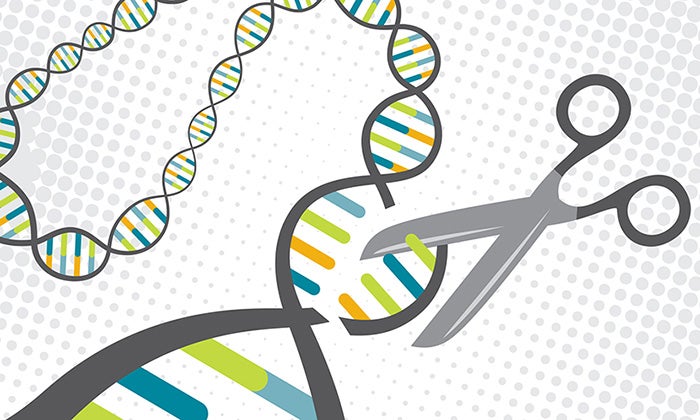Two Studies Shed Light on How Complex CRISPR Systems Work

In a pair of papers out this week, scientists at the University of Texas at Austin made new discoveries about a remarkable naturally occurring system known as CRISPR.
In one paper, just published in Cell, a team unlocked some of the secrets of how bacteria protect themselves from viral attack using the CRISPR tool.
While CRISPR is most well known for its role in gene-editing systems, it's actually a naturally occurring bacterial immune system. UT scientists, along with scientists at Cornell University, were able to observe in real time how different CRISPR proteins work together to build viral immunity into bacterial genomes. The finding contributes to a greater understanding of how the CRISPR system works.
CRISPR functions as repetitive segments of foreign DNA from a virus, which get inserted into the bacterial genome so that the bacteria can recognize the virus and neutralize it in future attacks. These viral DNA segments typically occur alongside a cluster of cas genes that encode various Cas proteins. (For what it's worth, CRISPR stands for clustered regularly interspaced short palindromic repeats, and Cas is short for CRISPR-associated.) Previous research has led to technologies that apply CRISPR-Cas9, CRISPR-Cas12 and other CRISPR enzymes to editing the genome of almost any living thing.
For the new study, the UT team, led by assistant professor Ilya Finkelstein in the Department of Molecular Biosciences, identified that a protein called Cascade first works in tandem with Cas3 to degrade and "chop up" viral DNA that is attacking a bacterial cell. Then Cas1-Cas2 works together with Cascade and Cas3 to insert the sections of viral DNA into the bacterial genome.
"We found we could see in real time how multiple proteins involved in this system work together," said Kaylee Dillard, a graduate student in Finkelstein's lab and one of the lead authors on the paper. "It's actually a really large, complex system."
The team used florescent markers to track the proteins and observe their movements in real-time, noting how they moved and worked together.
One possible use for this new understanding of bacterial immune systems could come in the fight against antibiotic-resistant bacteria. With greater understanding of CRISPR, it might be possible to target a specific pathogenic bacteria, like staphylococcus, and alter its genome, perhaps removing its ability to replicate or its antibiotic-resistant genes.
"We're a long way from that, but being able to target specific bacteria and not hurt the beneficial bacteria in our bodies would be great," Dillard said. "Hopefully, this work can provide insight that will be useful in the future."
Additional authors on the Cell paper include Maxwell Brown, Nicole Johnson, Erik Hernandez, Samuel Dahlhauser, Yoori Kim, Logan Myler, Eric Anslyn and Ilya Finkelstein of the University of Texas at Austin. Yibei Xiao, Adam Dolan and Ailong Ke of Cornell University also contributed. Funding was provided by the Welch Foundation and the National Institutes of Health.
Another paper from UT Austin scientists, also out today and published in the journal Molecular Cell, outlines how an unusual CRISPR fusion protein builds bacterial immunity to both RNA and DNA viruses.
Another team of scientists from the Department of Molecular Biosciences showed how Cas6 works in conjunction with a reverse transcriptase and the Cas1 fused into a cohesive protein unit to create a record of both RNA and DNA viral invaders in order to guide bacteria in combating future infections.
"This is a very unusual system," said Georg Mohr, a research associate in molecular biosciences who works in the lab of Professor Alan Lambowitz and is a lead author on the paper. "It's been speculated that CRISPR could be used in organisms to see what they've come in contact with because CRISPR creates a record in the genome that is also sorted in a timely manner. This is a hard copy of all the viruses that have been encountered. There is quite a bit of interest in using this in biotech or environmental settings."
RNA viruses are known to mutate quickly and are among the most dangerous to humans. They include diseases like Ebola, SARS, Rabies, influenza, polio and measles. A better understanding of how bacterial immune systems tackle RNA viruses and the record the CRISPR system provides, could be very useful to scientists.
"It had been a mystery why this fusion of proteins occurred because bacteria don't do things willy-nilly. They have to have a selective advantage," Mohr said. Combatting RNA viruses explains the advantage to bacteria, Mohr indicated. "This gives new insight into how bacteria and viruses interact and regulate each other."
Additional authors on the Molecular Cell paper include Jennifer Stamos, Laura Markham, Jun Yao and Alan Lambowitz of the University of Texas at Austin. Sukrit Silas and Andrew Fire of Stanford University, Kira Makarova and Eugene Koonin of the National Center for Biotechnology Information, and Patricia Lucas-Elío and Antonio Sanchez-Amat of Universidad de Murcia also contributed. Funding was provided by the National Institutes of Health, Stanford Graduate Fellowship, HHMI International Student Research Fellowship, the U.S. Department of Health and Human Services and the Spanish Ministerio de Economia, Industria y Competitividad.



